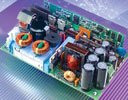

XP Power has announced that it has brought together a series of proven power supply design techniques in a new and innovative way to create the world's smallest 212 W, single output AC/DC switcher dubbed the EMA212.
Designed for communications applications, this power supply has been developed to meet the needs of networking equipment, voice over IP systems, wireless LANs, servers, storage area networks and post-production broadcast equipment.
Designers of such systems demand higher power from AC/DC units in industry-standard 1U formats as processing power and functionality grows within tight space constraints. The EMA212 can deliver over 200 W across the full universal AC input range from an industry-standard 76,2 x 127 mm (3 x 5 inch) footprint (34,04 mm high).
According to the manufacturer, the PSU has an efficiency of over 90% at full load, and needs only 12 CFM air-flow for full power operation at up to 50°C ambient and will operate at up to 70°C ambient with de-rating. The main output is 12 or 48 V d.c. but each power supply also has a 5 V, 100 mA standby output and a 12 V, 1 A output for powering a fan. The unit incorporates a fully featured signal set including AC fail/DC OK, active PFC, remote on/off and active current sharing.
Complementary design techniques
To achieve the EMA212's high performance, XP Power used various innovative design techniques. The size of the input filter was reduced with a 2-stage design using miniature, high permeability cores. These were stack mounted to minimise the PCB area and maximise cooling. The PFC circuit uses a silicon carbide diode to gain a further 1% efficiency over a traditional diode and snubber circuit combination, while a stepped-gap inductor, operating in continuous mode, reduces peak switching current and minimises filter requirements. Switching losses are virtually eliminated by using VA resonant zero current switching (ZCS) topology for the main converter circuit - switching occurs at zero current from 0-100% load. Additionally, a 100 kHz switching frequency enables the use of small magnetic components without compromising efficiency. In the main converter, a ceramic substrate replaces the conventional heat sink, offering additional space savings. The same thermal management technique is used for the output rectifiers. Here, the adoption of synchronous rectification eliminates nearly all switching losses, keeps noise levels low, and minimises both costs and board area. Power factor correction (PFC) is achieved using a one cycle control (OCC) circuit, rather than an average current control mode operating over several cycles. This OCC technique eliminates six passive components, saves PCB space and reduces cost.
Overcurrent, overvoltage and short circuit protection are all built into the EMA212 and the power supply meets all major international specifications for safety and EMC performance.
| Tel: | +27 11 454 8053 |
| Email: | [email protected] |
| www: | www.vepac.co.za |
| Articles: | More information and articles about Vepac Electronics |

© Technews Publishing (Pty) Ltd | All Rights Reserved